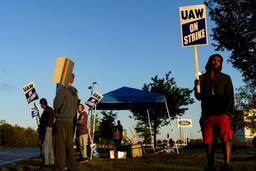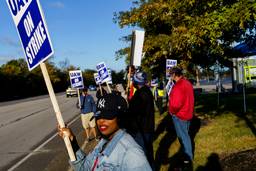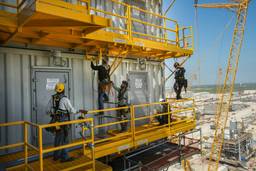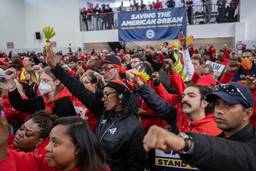UPS and Teamsters Have Reached a Tentative Deal, May Avoid Strike
The tentative agreement, which must be ratified by the union’s membership, apparently includes wage increases and an end to a two-tiered wage system.
Teddy Ostrow and Stephen Franklin
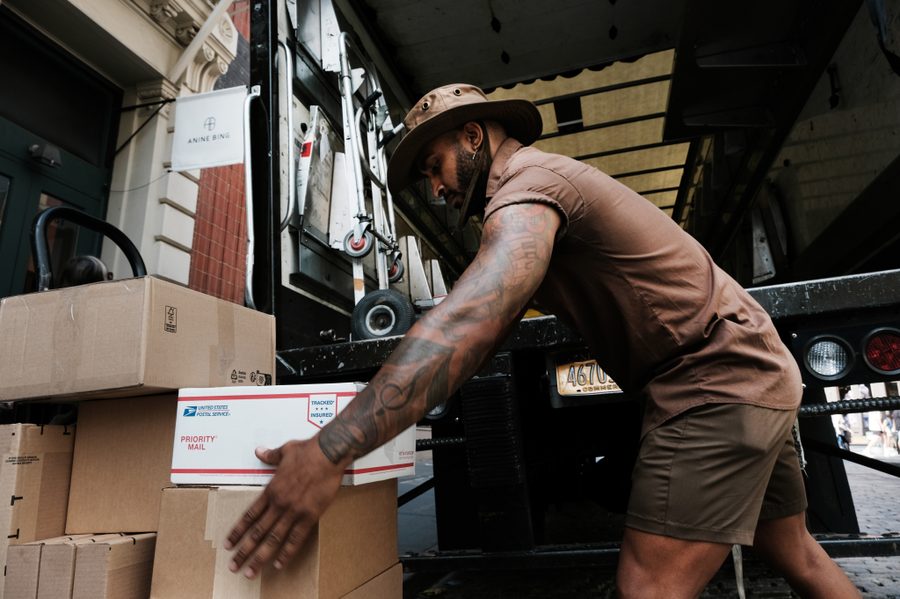
[This article was substantially updated at 6 p.m. CST]
The Teamsters and UPS announced Tuesday morning that they had reached a tentative deal in what had been contentious negotiations — and not a moment too soon. The Teamsters’ contract with United Parcel Service (UPS) — covering some 340,000 U.S. workers — expires in about a week. That’s when the Teamsters had said they would go on strike — one of the largest at a single employer in decades — if no deal was reached.
The tentative agreement, which must be ratified by a vote of Teamsters members, includes what the union describes as “historic wage increases” for full-time and part-time UPS Teamsters; the end of a despised two-tier wage system among delivery drivers; the creation of thousands of new full-time union jobs; the targeted installation of air conditioning in new package cars (purchased after Jan. 1, 2024) and other measures to protect drivers against the heat; limitations on forced overtime and Martin Luther King Jr. Day as a paid holiday, among other measures.
“We demanded the best contract in the history of UPS, and we got it,” Teamsters General President Sean M. O’Brien said in a news release following the announcement of the tentative deal. “UPS has put $30 billion in new money on the table as a direct result of these negotiations. We’ve changed the game, battling it out day and night to make sure our members won an agreement that pays strong wages, rewards their labor and doesn’t require a single concession.”
UPS also confirmed the tentative deal Tuesday morning. “Together we reached a win-win-win agreement on the issues that are important to Teamsters leadership, our employees and to UPS and our customers,” Carol Tomé, UPS’ chief executive officer, said in a news release posted on the company’s website. “This agreement continues to reward UPS’ full- and part-time employees with industry-leading pay and benefits while retaining the flexibility we need to stay competitive, serve our customers and keep our business strong.”
Sean Orr, a package car driver and shop steward with Local 705 in Chicago, tweeted that “Today, nearly 350,000 warehouse workers and truck drivers forced concessions from a $100 billion corporation. This comes after two decades of fighting concessionary contracts from weak union leadership, and fighting daily battles on the shop floor.”
“The rank & file changed the leadership of our union two years ago. Now they will decide whether to accept these concessions from UPS, or demand even more. Our coworkers will look at the TA for what it is — with open, honest eyes — and decide to accept or reject it,” the tweet thread continued. Orr is co-chair of Teamsters for a Democratic Union and is also in a leadership position with Democratic Socialists of America, who have been active supporters of the Teamsters.
Representatives from the Teamsters’ 176 UPS locals will meet on July 31 to review and may then recommend the tentative agreement to their locals, which rank-and-file union members would then vote on in the coming weeks, according to the news release. Members will also vote on their region and local-specific supplementals, which must be approved before the national contract can go into effect. Union membership voting will begin on August 3 and conclude on August 22.
However the situation winds up, the circumstances surrounding the ratification — or not — of this agreement are a far cry from when the Teamsters last went through this process. During previous negotiations between the UPS and Teamsters about five years ago, the union agreed to a new tier of jobs for drivers that pays about 13% less than other full-time workers and provides less protections. Union membership had rejected that contract, furious over the tiered system. But union officials, led by former General President James P. Hoffa, invoked an obscure rule in the union constitution and agreed to the contract despite the membership’s vote.
That situation, where the union’s leadership can overrule the membership’s vote because of that obscure rule, won’t happen this time around because the union has since done away with that rule.
It was largely unclear on Tuesday how the larger union membership views the news of the tentative agreement; members will receive a list of contract changes, and locals will conduct member meetings to go over them.
Several UPS Teamsters interviewed for this article said they were cautiously optimistic about the tentative agreement, but were withholding judgment until they saw details of the plan.
“I’m proud of the hard work that our negotiating committee and IBT leadership has done. This contract appears to be a great offer, reflecting the hard work of the many UPS Teamsters during historic times, like Covid,” says Elbe Lieb of Local 135 in Indiana. “While at first blush I am positive of the economics and other wins, especially for part-timers, there are other issues that are open questions. I am [eagerly] anticipating reading the full TA to see how things pan out.”
Patrick Leonard, a UPS Teamsters driver with Local 251 in Rhode Island, echoed a similar sentiment and says he is “tentatively happy … but I want to see the language surrounding some specific issues.”
Corey Levesque, a package car driver and shop steward also with Local 251, says that most of the reactions he has seen have been positive but that they “would love to see the language.”
“From my perspective, we are seeing major improvements across all classifications,” says Levesque.
Zakk Flash, a package car driver with Local 886 in Oklahoma City, says that “drivers, clerks, loaders and package handlers living and working in Oklahoma will see their communities lifted up with the success the Teamsters have made at the negotiating table.”
And Tony Rosario, an organizer with Local 804 in New York, says that “this is a big win for workers everywhere” and that “it shows that when workers stand together and prepare to withhold their labor with an actual viable threat to strike, there is nothing we can’t accomplish.”
To be clear, the deal is only a tentative agreement, and it remains to be seen if all sides are going to avoid a strike that could be one of the largest at a single employer in decades.
And while many Teamsters and UPS leadership were optimistic about where negotiations landed, there were clearly some union members who were not thrilled with the deal. It remains to be seen how large of a group that could be.
“Looking over the highlights released by the IBT of what will be in the TA, I find myself disappointed. Instead of equity, the IBT seems to have created yet another pay tier for part-time UPS. I will await the release of the TA before making a recommendation on voting,” says Jennifer Hancock, a part-time UPS employee for more than 30 years with Local 322 in Richmond, Virginia.
Another UPS Teamster, who asked not to be identified because of the sensitivity of circumstances surrounding their organizing work, insists that it is still necessary for the Teamsters to go on strike.
“To me, it is not a question that we need to strike. After seeing this tentative agreement, my opinion has not shifted, and, for that reason, I cannot vote this contract in. Striking against UPS, and all the political and economic forces lined up against us, is the only way we will have a fighting chance at taking from UPS the demands many part-timers in particular have made and gain back what has been snatched from us for decades,” they say. “We have the opportunity to inspire Amazon workers and workers in general across society that we can and should dare to wage difficult battles against the many forces lined up against us, and only if we do this will we be able to turn the tides and fight for a society and economy truly determined by and for workers. And for that reason we must, without question, strike.”
But Vinnie Perrone, president of Local 804, says that he thinks “members are going to really like the agreement overall” and that “you can’t please every single person but overall, with the improvements, it’s going to propel the Teamsters to better heights.”
“There’s other very profitable corporations out there like UPS that make even more money than UPS. Amazon is a perfect example. The teamsters are setting the standard of what people should be getting. It’s going to open people’s eyes, to say we need to get paid what we’re worth. To stop it with the throwaway jobs and gig work.”
The tentative deal on the five-year collective bargaining agreement comes on the first day both parties returned to the bargaining table after negotiations broke down on July 5.
When negotiations broke down then, it signaled a higher likelihood that a strike was possible, as both sides geared up preparations. UPS said it was training non-union members to potentially step in to continue services to its customers if a strike was called, and the Teamsters sped up practice picketing and laid out plans for pickets. Meanwhile, the union for UPS’ almost 3,500 pilots, who facilitate deliveries in the U.S. and around 220 other countries and territories, said it would observe Teamsters’ picket lines as it did during the 15-day strike by 185,000 Teamsters in 1997.
Worries also grew about the broad economic impact of a shutdown, with one estimate of the financial impact of a 10-day strike, from the Michigan-based Anderson Economic Group, foreseeing a potential $816 million loss for UPS and a $2.8 billion loss to consumers and businesses.
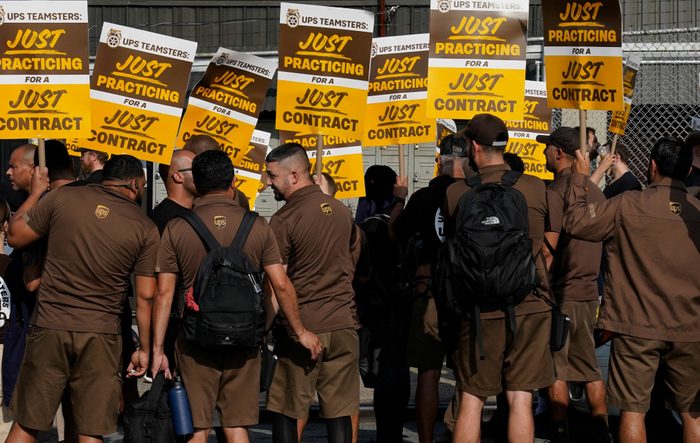
Several of the union’s key demands had been addressed prior to Tuesday’s announcement. The specific language of the tentative agreement has not yet been released publicly, but according to the union, UPS had already agreed to remove a second tier of lower wages for drivers working Tuesday to Saturday and agreed to begin air conditioning and cooling its vast fleet.
But several items remained on the bargaining table, including surrounding the wages of part-time workers. According to the Teamsters’ news release, full-time and part-time workers’ wages would immediately hike by $2.75 per hour, and workers would see a total of $7.50 in general wage increases over the course of the five-year contract.
Existing part-time workers would immediately see their wages raised to no less than $21 per hour, which would be the new base rate for part-time package handlers and would increase to $23 per hour by the contract’s end, according to the union. Part-timers who already earn more in wages from the company’s location-specific market rate adjustments would receive general wage increases, and long-time part-time workers would also receive longevity, or “catch-up,” wage increases up to $1.50 per hour (in addition to the new hourly raises).
According to the Teamsters news release, “General wage increases for part-time workers will be double the amount obtained in the previous UPS Teamsters contract — and existing part-time workers will receive a 48% average total wage increase over the next five years.”
In addition to the general wage increase, full-time drivers would also see their average top rate moved to $49 per hour from $42, and all second-tier delivery drivers would be reclassified as regular package car drivers and placed into seniority.
UPS’ concerns going into the talks were, in part, about keeping costs in check amid much increased competition from largely non-union competitors with lower wages, explains a UPS spokesperson speaking on background. The company’s goal, they said, was maintaining “flexibility” as it competes in a much-changed market.
Spurred by home-bound buying during the pandemic, UPS’ revenues soared in 2022 to over $100 billion, up from $84 billion in 2020.
Meanwhile, what will become of the company’s seasonal gig workers, known as personal vehicle drivers (PVDs), who deliver packages out of their private vehicles during peak season, was also a remaining sticking point in negotiations. The union says that part-timers would be given priority to take on PVD positions, with an eight-hour guarantee. This seasonal work would be limited to five weeks between November and December, whereas previously such work lasted from October to January.
A spokesperson for UPS was not able to immediately confirm the accuracy of the details in the Teamsters news release about the tentative agreement. UPS officials would also not confirm or deny the union’s estimate that the contract package is worth $30 billion and said the cost of the deal will be covered when the company reports its second quarter earnings on Aug. 8. UPS stock, which has been growing since late June, hit $191 just before noon today, and fell to $184 by early evening.
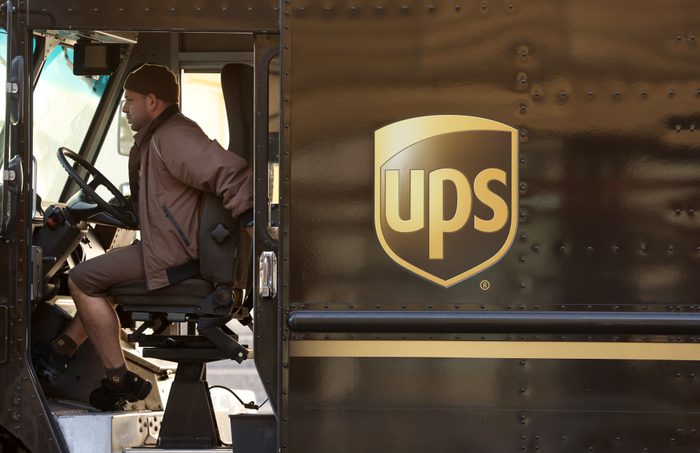
The nation’s long-suffering labor movement seemed inspired by O’Brien’s vows to erase the Teamsters’ lack of bargaining transparency under former General President James P. Hoffa. Coinciding with strikes by the actors and writers unions, the Teamsters’ hardball bargaining seemed an omen that labor had renewed a winning mojo.
“We will set the tone for organized labor and the entire country with this contract. There is no better organization to set that bar high than the International Brotherhood of Teamsters,” O’Brien had said at an April meeting. “We are not going to accept and take what UPS gives us. UPS Teamsters have fire in their eyes and the intestinal fortitude to take on this company.”
His claim does indeed echo and resonate.
“There’s clearly some kind of convergence happening. I’m in L.A. so I’m seeing that in real time. You go to the picket lines and you’re seeing the writers, actors, hotel workers, teachers and Teamsters coming together, showing solidarity. It’s pretty electrifying for the people that are there. There’s this sense of shared fate, which is a necessary precondition for solidarity, and building a broader movement that has been lacking,” says Barry Eidlin, an associate professor of sociology at McGill University.
The question for organized labor now, he adds, is where this is all headed.
“The point still stands that we need to keep things in perspective. We’re talking about recapturing the Reagan era in terms of strike frequency. But getting to 1940s and 1970s levels of strikes also involves passing through the Reagan era. There’s a big difference between now and the big strikes of the 1970s and 80s, many of which were defensive in nature,” says Eidlin.
The threat of strikes then, he explained, were often used by union leadership to scare members into swallowing concessions. Today, the strike threat is squarely used as leverage against the company. “Now, we’re seeing a smaller level of upsurge, but there’s signs that we’re seeing the trajectory pointing upwards.”
Teddy Ostrow is a journalist from Brooklyn covering labor and economics. He is the host of The Upsurge podcast and his work has appeared in The Nation, The New Republic, and elsewhere. Follow him on Twitter @TeddyOstrow.
A former labor writer for the Chicago Tribune, Stephen Franklin is a Pulitzer Prize finalist and an adjunct professor at the University of Illinois Urbana-Champaign School of Labor and Employment Relations.

